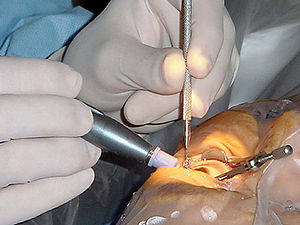 Image via Wikipedia
Image via WikipediaFor most people, cataracts are all part and parcel of the normal aging process. Indeed, the most common type of cataracts are those that develop as a result of the aging process. They are known as senile cataracts and it’s unusual for senile cataracts to be diagnosed in those under the age of 60. The cataracts develop as a result of changes in the protein structures within the lens of the eye. These changes usually happen very slowly and it can take years for cataracts to develop. Gradually, as the cataract grows, the lens becomes cloudy and vision is interfered with.
It is also unusual for cataracts to develop rapidly - although this not unheard of. Indeed, the development of cataracts is quite unpredictable. In some cases cataracts remain small, never progressing to the point where they affect vision and require treatment - but for most people treatment will eventually be needed. And even though cataracts commonly affect both eyes, it’s not uncommon for a cataract in one eye to grow more quickly than the one in the other eye.
And because cataracts tend to develop over such long periods of time, many patients are not diagnosed until their cataracts are quite well advanced. In fact, being diagnosed with senile cataract might come as a real surprise to you because in the early stage of their development you might not experience any vision problems at all. As such having cataracts might be something that is picked up during a routine eye examination rather than with you presenting with symptoms.
There can be no doubt that senile cataracts pose an enormous medical problem - not just to the individual sufferers who find that they may increasingly face difficulties in doing things that they were previously capable such as driving at night and reading, but also for the community as a whole.
Just look at the statistics in the US. By the time they have reached the age of 80, over half of all Americans will either have a cataract or have had cataract surgery. Currently, over 1.5 million cataract surgeries are performed in the US every year. This makes cataract surgery the most costly surgical expense in the US coming in at a staggering $3.2 billion p.a. Experts estimate that visual disability associated with cataracts accounts for over 8 million physician office visits a year! And as populations begin to age, with more and more people living for longer, these figures are set to rise.
Fortunately, Carnosine Drops now offer a viable alternative to the huge cost of treating cataracts surgically. Regular use with these amazing cataract eyedrops, gently but effectively breaks down the cataracts alleviating the need for surgery.
Resource - Health Guide : Age Related Cataracts

No comments:
Post a Comment